Introduction
The watchdog organization Parents Defending Education (PDE) recently revealed that over $1 billion in federal grant funding has been distributed by the U.S. Department of Education to promote “diversity, equity, and inclusion” (DEI) in K-12 schools and universities across the country in the past four years alone. Unfortunately, this massive federal footprint is dwarfed by the in-kind contributions forcibly extracted from students and state taxpayers for DEI efforts, all under the watch of their local lawmakers in both red and blue states alike.
The PDE report follows similar research by the free speech advocacy organization Speech First that issued a landmark report in April 2024 titled No Graduation Without Indoctrination, which revealed that fully two-thirds (67%) of U.S. colleges and universities “require students to take a DEI-related class to graduate.” Building off the work of Speech First, this analysis quantifies the financial implications of these DEI mandates on students and state taxpayers.
Executive Summary
- Public universities from at least 30 states require all undergraduate students to complete a diversity, equity, and/or inclusion (DEI) course to even be allowed to graduate with a degree from a state taxpayer-funded institution.
- Red and blue state lawmakers alike currently permit these practices, fueling greater financial subsidies for DEI than even the Biden administration provides.
- DEI general education course mandates cost students and state taxpayers at least (and likely more than) $1.8 billion via tuition and state appropriations over each four-year period in which undergraduate student bodies must complete these requirements — and this is a very conservative calculation.
- The current undergraduate population at public universities will spend at least 40 million student hours satisfying mandatory DEI general education course requirements at their respective state institutions simply in order to graduate.
- Various public university faculty senate bodies have forced degree-specific DEI content to be embedded into all majors and/or given financial kickbacks to professors who infuse DEI content into their existing classes. (Due to such practices, the actual overall financial investment in DEI-laden coursework at public universities is likely dramatically greater than the cost estimates included in this report.)
- Even uncontroversial-sounding DEI labels in red states, such as Iowa State University’s recently renamed “U.S. Cultures and Communities” requirement, directs students to explore “intersectional understandings of diversity” and “analyze systemic oppression and personal prejudice and their impact on marginalized communities and the broader U.S. society.”
- Other, more nakedly political DEI general education courses, such as the University of Virginia’s “‘Hateinnany’: Fascism, Antifascism, and the Global Far Right,” even offer course descriptions explicitly naming President Donald Trump in the context of “far right politics” and “fascism.”
- State lawmakers must 1) build upon the work of Florida, where Governor Ron DeSantis signed legislation successfully eliminating DEI classes from the general education catalog at state universities, and 2) adopt the Goldwater Institute’s Freedom From Indoctrination Act to prevent similar mandates from being applied to students or faculty at the college, department, or program level as is increasingly common.
Methodology
Identifying DEI Course Mandates
In its 2024 report, No Graduation without Indoctrination, the free speech advocacy organization Speech First surveyed nearly 250 higher education institutions across the country, finding that two-thirds (165) “require students to take a DEI-related class to graduate.” Despite the extensive reach of this survey, Speech First noted that even these figures comprised only a subset of public and private universities nationally:
“Speech First Investigated schools that fell under at least one of these four criteria—Spring 2023 NCAA Division 1 Conference Membership, US News Ranking 2023 of Best National Universities, Endowment Over $1 Billion, and Top 100 of Undergrad Enrollment— to ensure that all 50 states were represented.”
Utilizing the roster of institutions produced by Speech First, this new Goldwater analysis has further reviewed the identified DEI requirements at each public four-year institution. From this slate, Goldwater has identified a roster of 74 public university campuses across 30 states—together serving over 1.4 million full-time undergraduate students—that have a DEI course requirement for all undergraduates.
While many of these institutions require students to complete multiple courses related to “diversity,” Goldwater has excluded most requirements primarily focused on courses dealing with international cultural education including foreign languages, world histories, etc., focusing primarily on DEI course mandates — whose formal parameters are almost invariably focused upon race, ethnicity, gender, and/or “marginalized” or “oppressed” populations — and identity politics and associated issues of “structures” and “inequity” within the U.S.
This analysis also conservatively excludes from Speech First’s original roster several institutions whose DEI requirements are applied at the school/college, department, or program level, rather than university-wide to all undergraduates. (Note these institutions together have an undergraduate enrollment of over 100,000, and most of these excluded DEI requirements still apply to a plurality, if not majority, of students).
As noted below, additional parameters further limit the scope of institutions reviewed in this analysis, further understating the likely extent and total cost of DEI course mandates nationally. In short, the numbers below—as striking as they are—reflect only a sliver of the actual overall costs borne by students and taxpayers.
Financial & Enrollment Data
For each institution identified above, this analysis has drawn upon the U.S. Department of Education’s National Center for Education Statistics Integrated Postsecondary Education Data System (IPEDS), which collects detailed enrollment and financial information from nearly every college and university in the nation.
Specifically, the analysis uses the institutions’ self-reported 2022 IPEDS data points below to create several potential cost estimates of the DEI course mandates:
- Total full-time undergraduate enrollment
- In-state average tuition for full-time undergraduates
- In-state required fees for full-time undergraduates
- In-state per credit hour charge for part-time undergraduates
- Revenues from tuition and fees per FTE student
- Revenues from state appropriations per FTE student
- Instruction expense per FTE student
Using these data points, this analysis provides multiple measures of the costs per required DEI course at each institution:
Cost estimate 1: Annual in-state tuition (divided by 8 courses)
Given the standard undergraduate course load of four courses per semester and two semesters per year, the “cost” of each required DEI course can be considered as one-eighth of an institution’s published annual tuition cost and mandatory fees.
However, as public universities such as the University of Texas at Austin are often quick to remind state legislators, “Less than half the cost of a student’s education is covered by tuition.” With many students paying substantially less than the standard sticker price, and others (i.e. students paying out-of-state rates) paying substantially more, those annual in-state tuition rates provide only a rough guidepost of the actual financial investment required to provide instruction.
As a result, this analysis also provides multiple alternative cost calculations to estimate the cost of DEI courses:
Cost estimate 2: In-state per credit hour charge (x 3 credit hours per course)
In addition to their annualized tuition rates, most institutions also report via IPEDS an “in-state per credit hour charge for part-time undergraduates.” Using this measure, multiplied by the standard three-credit hours per course, provides an additional estimate of the cost per typical course. (Note: IPEDS instructs institutions not to include fees in this measure.)
Cost estimate 3: Annual instruction expenses per student (divided by 8 courses)
As an additional alternative measure, institutions report their “Instruction expenses per FTE student.” Unlike the tuition and credit hour cost measures, this measure is based on the institutions’ actual expenditures per student. This analysis divides the annual instruction expense per student by the standard eight courses taken per year to provide an additional estimate of the cost per course.
Cost estimate 4: annual revenues from tuition and state appropriations per student, (divided by 8 courses)
The primary objective of students attending public colleges is (at least ostensibly) the completion of their academic studies, which state taxpayers also help subsidize through significant appropriations of state tax revenues. While university administrators deploy these funds toward a number of purposes of varying legitimacy, the combination of tuition and state revenues together broadly represent the resources available to execute on the institutions’ core academic mission (setting aside additional infusions of federal research grants, endowment earnings, etc.).
As such, this analysis considers the sum of “revenues from tuition and fees per FTE student” and “revenues from state appropriations per FTE student” as an additional lens—one that captures the broader war chest of funds available to be deployed for each of the standard eight courses per year (if they were not diluted by other spending decisions).
Unlike the isolated “instructional expenses” estimate provided above, this estimate captures the reality that paying for students’ instruction also entails related administrative functions necessary to support that instruction. And, given that tenure track faculty devote as little as 40% of their salaried time to instruction, it is worth recognizing that retaining sufficient faculty to teach required courses typically entails supporting their larger research activities, etc., as well. Unfortunately, such research conducted by the faculty teaching mandatory DEI courses may simply echo even further the activist-driven agenda that students and taxpayers are already being forced to subsidize on the instructional side.
Given that scholars (and former faculty) such as Dr. Jay Greene of the Heritage Foundation have likewise demonstrated that university DEI staff often outnumber the faculty of various departments, it is not difficult to see how the revenues generated nominally to support academic course offerings are in fact used to prop up institutional bloat and waste.
Calculating Total Costs of DEI Course Mandates
Using each of the four cost estimate approaches above, this analysis multiplies:
The full-time undergraduate population of each institution X the number of required undergraduate-wide DEI general education courses per student X the cost per DEI course.
As described at greater length amid the examples below, universities typically do not expand the total number of required courses a student must complete in order to satisfy their DEI requirement. Rather, these requirements simply displace or transform existing core course requirements, ensuring that students are all forced to invest at least a semester’s worth of time and tuition dollars on one or more DEI-infused classes. Absent this mandate, students could either a) complete their studies with one fewer course, or b) apply their tuition costs to a more academically relevant course of instruction in its place.
Findings
#1) DEI course titles often appear uncontroversial, even when infused with ideologically charged identity politics.
DEI course requirement labels vary substantially across campuses, ranging from the generic “U.S. Diversity, Equity, and Inclusion” (North Carolina State University), to the innocuous-sounding “American Cultures” (UC Berkeley), to the more openly identitarian “Race, Power and Justice in the United States” (University of Minnesota’s forthcoming rebrand) and “Difference, Power, and Discrimination” (Oregon State).
In virtually all cases, DEI general education course mandates require students to choose from among an approved subset of courses, rather than requiring all students to take one single, common foundational course. (Note this is not necessarily true for program-specific requirements.)
DEI course mandates therefore include a mix of eligible classes —some of whose titles are self-evidently steeped in “intersectional” identity politics of race and gender, while other course titles often provide no discernable indication thereof.
At institutions such as the University of California San Diego, for example, classes satisfying the DEI general education requirement include various ideologically charged titles such as:
“PowerWealth&Inequality/HumDev,” “Economics of Discrimination,” “Latin American Studies & US Liberation,” “Latinx Theatre and Performance Power,” “Race and Racisms,” and “Biology of Inequality.”
Yet at the same time, UC San Diego’s DEI requirement can also be satisfied by taking courses such as “Child Family Community,” “Language, Culture, & Education,” “Digital Media Literacy,” “Early Childhood Development & Education,” “Asian American Literature,” “Philosophy in the Americas,” and “Mindfulness and Education.”
Given the plethora of such titles indicating no particular identity-based divisiveness or discrimination, one might argue that such courses should not all be lumped in with (or counted for cost purposes) alongside the more ideologically antagonistic subset of DEI courses listed previously. However, UC San Diego’s screening process for DEI courses makes clear that even these seemingly benign and completely apolitical topics have been infused with race- and gender-based identity politics.
Per its “DEI Course Proposal Submission Form,” for UC San Diego faculty seeking to obtain approval for their classes to meet the DEI requirement, “at least 30% of a course’s content should be devoted to the analysis of inequity with respect to one or more of the following groups: African American/Black Diaspora; Asian American and Pacific Islanders; LatinX/Chicanx; and Native Americans/Indigenous.” Likewise, faculty must satisfactorily answer, “Does the course examine the intersection of inequity based on dimensions of identity such as class, gender, LGBTQ identities, disability, citizenship, colonialism, and/or religion?”
In other words, courses are literally screened out if they don’t devote at least 30% of their course content to “racial inequity” or if they fail to embrace “intersectionality,” the topic pioneered by Critical Race Theorist Kimberle Crenshaw.
Figure 1: Excerpts of Faculty Submission Form to Obtain DEI Course Designation at UC San Diego

Perhaps even more strikingly, as part of this system, UC San Diego is even actively paying faculty special bonuses to infuse DEI into their existing courses:
“To provide course diversity and encourage new courses, Senate faculty may be provided $1,500 for new or substantially revised courses approved by UGC to fulfill the DEI requirement. Course proposals should be developed through a mini-grant and review process. This proposal should be submitted along with the syllabus, eCourse form, budget justification and DEI response form.”
Elsewhere, at the University of Louisville, courses such as “Children’s Literature,” “Popular Music in American Culture,” and “Higher Education in the U.S.” are all categorized as meeting students’ “D1 U.S. Diversity” core requirement. Despite none of these titles indicating anything remotely connected to identity politics, the university’s “Cardinal Core” (general education) parameters make clear:
“Students who satisfy this requirement will demonstrate that they are able to … Identify how historical, social, and cultural structures and processes shape understandings of race, class, and gender and/or their interaction with other social demographics in the U.S.”
Figure 2: University of Louisville “Cardinal Core” General Education Diversity Requirements
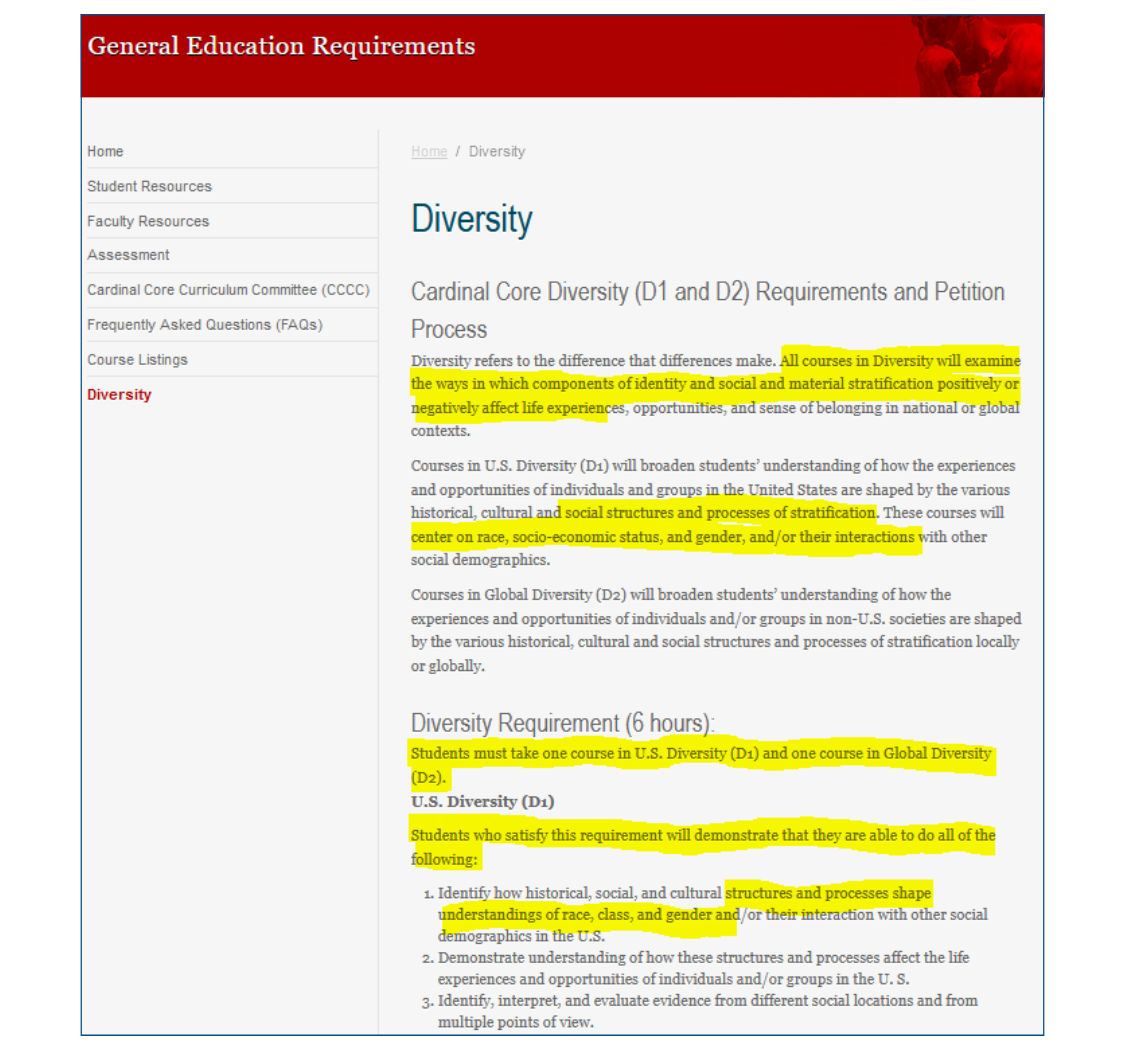
At the University of Oregon, courses on topics ranging from “Ethics” to “Film, Media, and Culture” to “Introduction to Native American Literature” all meet the university’s DEI requirement. Once again, despite such seemingly unremarkable titles, these courses:
“Fulfill the United States: Difference, Inequality, and Agency category of the Cultural Literacy Core Education requirement, a requirement informed by UO student activism. It is meant to develop students’ analytical and reflective capacities to help them understand and ethically engage with the ongoing (cultural, economic, political, social, etc.) power imbalances that have shaped and continue to shape the United States…”
All courses meeting the necessary criteria must require students to “inquire into intersecting aspects of identity such as race, gender, gender identity, sexuality,…analyze uses of power to marginalize on the basis of identity, as well as the assertions of agency, resistance, and resilience by marginalized groups; and…examine historical and contemporary structures,…cultural practices, or ideologies that perpetuate or change the distribution of power in society.”
Figure 3: University of Oregon DEI Requirement Parameters
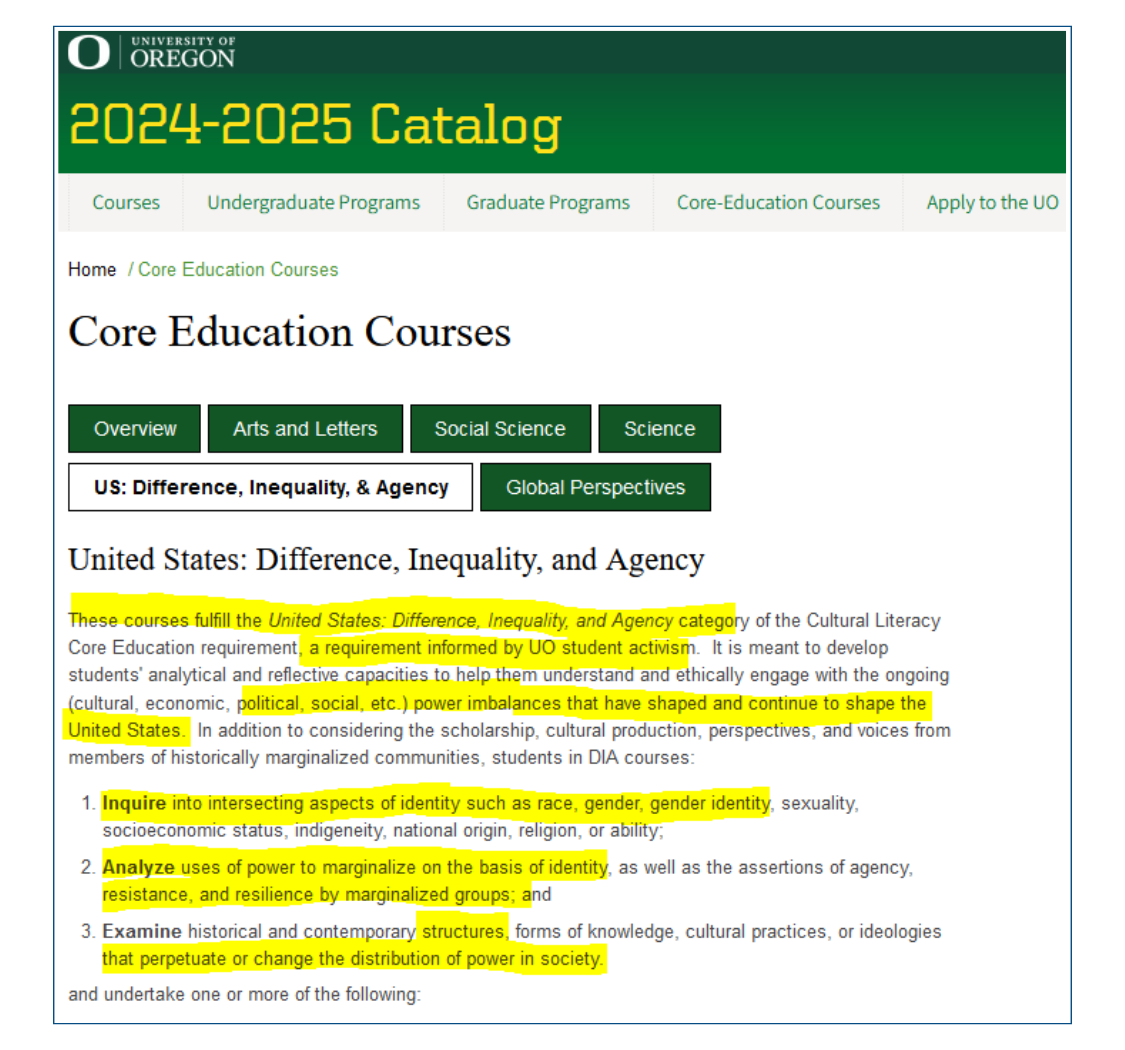
Lastly, despite the uncontroversial label of Iowa State University’s DEI course requirement, “U.S. Cultures and Communities,” students are directed to explore “intersectional understandings of diversity” and “analyze systemic oppression and personal prejudice and their impact on marginalized communities and the broader U.S. society.”
Figure 4: Iowa State University DEI Requirement Parameters

In short, even among DEI general education requirement labels (and the course titles that satisfy them) that indicate little evidence of political activism or racially charged instruction, the fine print and/or supporting documentation tends to reveal a systematic emphasis on “oppression,” “marginalization,” “intersectionality,” “structured inequality,” “privilege,” and/or “discrimination” in even many of the most innocuous topics.
#2 Rather than—or in addition to—simply implementing a university-wide “general education” DEI component, public universities often seek to embed similar requirements into the specific degree programs, department, and/or colleges within the university.
As Indiana University – Bloomington declares, for instance, as part of its “Shared Goals” requirements, which are “program-specific and vary depending on major and school,” (emphasis added) the “faculty of each undergraduate degree-granting unit must adopt a degree requirement appropriate to their curriculum that addresses issues of diversity in the United States…and cultural, racial, ethnic, class, age, ability, sexual orientation, religious, and gender discrimination…”
Figure 5: Indiana University – Bloomington DEI Requirements at the Major Level
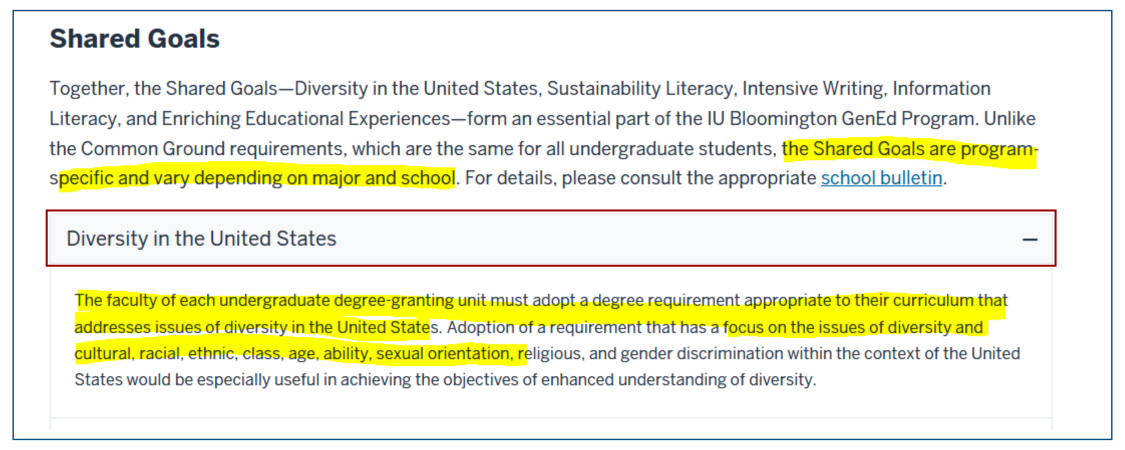
At the University of Maryland, a ”Diversity Education Task Force—co-chaired by faculty and the school’s dean of undergraduate studies—unveiled a proposed roadmap in 2020 to not only rename the university-wide DEI course requirement from “Understanding Plural Societies” to “Understanding Structures of Racism and Inequality” (subsequently enacted with a 99-8 faculty senate vote in 2022), but also to require every major to embed DEI content into its core coursework. As proposed by the task force:
“We recommend that faculty members in each department and college be asked to review their undergraduate major degree requirements regarding discipline-relevant diversity, inclusion and civic engagement content. Where such content is absent or limited, they would be asked to identify appropriate learning outcomes and to use these as a basis for introducing or augmenting current instruction.”
As this document noted, “many degree programs already include relevant coursework (e.g., College of Education, School of Public Health); this initiative would extend this to all campus majors.”
Figure 6: University of Maryland Diversity Task Force Recommendation to Full Faculty Senate to Require infusion of DEI Courses into All Majors

Other institutions have likewise operationalized similar approaches. The University of Texas at Austin previously declared “The undergraduate college is working with the dean’s offices in each of the colleges and schools on timelines for including Flag requirements in their degrees. All students will eventually be required to earn…one Flag in each” area, which now includes “Cultural Diversity in the U.S.”
#3 In some cases, DEI instruction so blatantly crosses lines of overt political partisanship as to defy belief
Despite their intrinsically ideological nature, DEI courses tend to at least eschew overt, partisan language in their course titles and descriptions. However, courses meeting DEI general education requirements in some instances exhibit less restraint.
University of Virginia: Where DEI = Anti-MAGA Instruction
As one particularly notable example of DEI course mandates embedded at lower levels of the university, the University of Virginia’s Arts & Sciences general education requirements include the invitingly labeled “Engaging Differences” course requirement. Despite the upbeat label, courses satisfying this requirement are intended to ensure that students will “encounter a range of contexts in which people differ, including distinctions of culture, religion, and nationality, as well as those of class, race, gender, sexuality, ability, privilege, and power,” and that they will “consider how we develop and experience bias and discrimination, inclusion and exclusion.”
Yet even such typical DEI language fails to capture the full extent of the nakedly political narratives promoted under UVA’s “Engaging Differences” banner in practice. Indeed, consider the very first course listed as meeting this requirement, whose course description explicitly names President Donald Trump in the context of “far right politics” and “fascism”:
EGMT 1530: “Hateinnany”: Fascism, Antifascism, and the Global Far Right: The 2010s saw an explosion of interest in the growth of the global far right. From the rise to power of right-wing populists like Narendra Modi in India, Viktor Orbán in Hungary, Boris Johnson in Great Britain, Rodrigo Duterte in the Philippines, Jair Bolsonaro in Brazil, and of course Donald Trump in America…focusing primarily on Western Europe and North America, but paying close attention to the concept of “empire,” its importance in the right-wing imagination in imperial states, and the impact of decolonization on far-right politics and what develops into the self-described “white power” movement at the end of the century.
Figure 7: University of Virginia General Education Course on Donald Trump, “Fascism,” and the “Global Far Right”
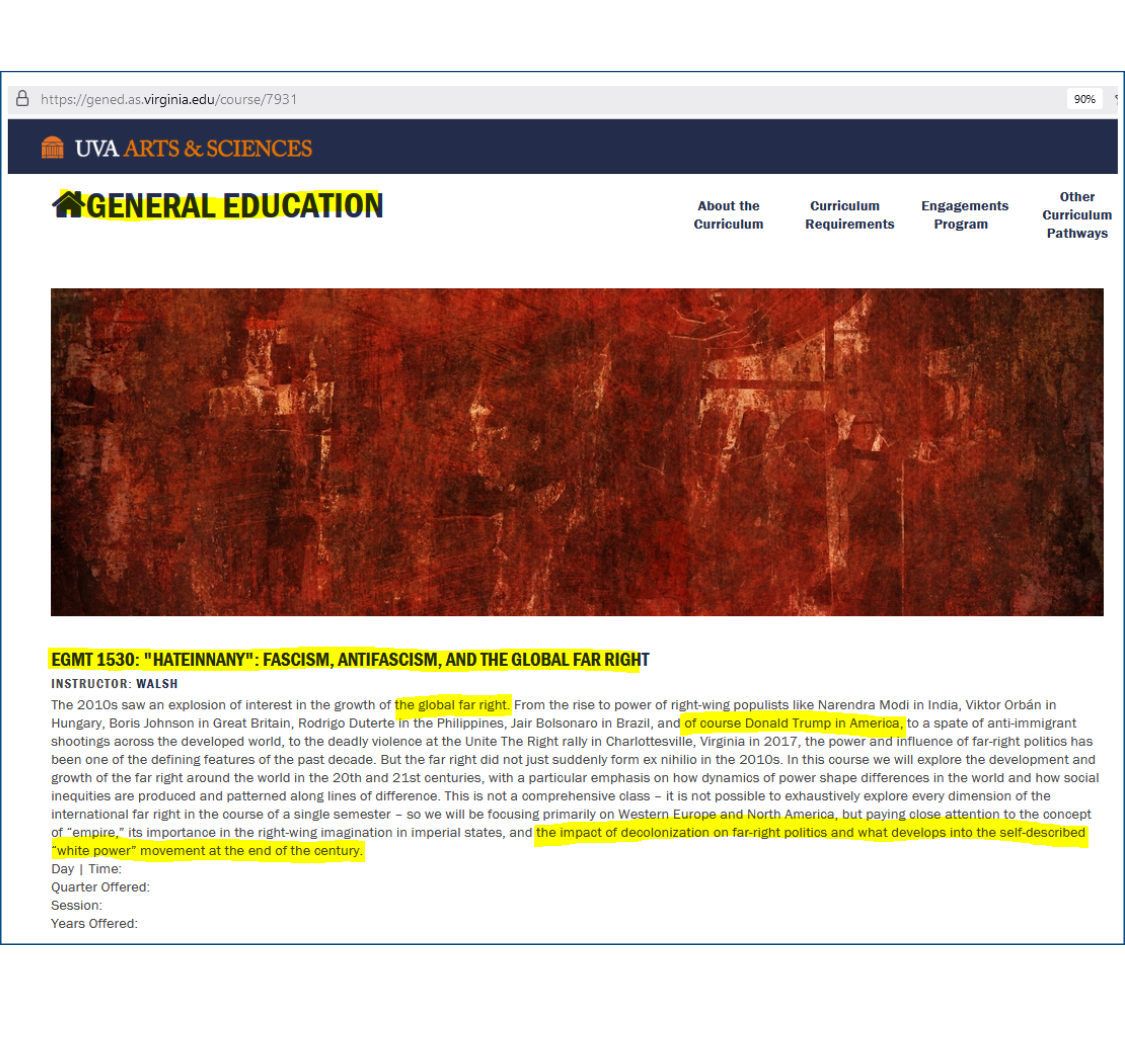
The Cost of DEI Course Mandates; Billions of Dollars, Millions of Hours
Having reviewed the sweeping—and often shockingly political—nature of university DEI course requirements, this analysis captures the quantitative scope of their reach.
DEI General Education Mandates Consume Tens of Millions of Student Hours
Specifically, using the methodology described above, the report finds that across 74 public university campuses determined to have undergraduate-wide DEI course requirements, more than 1.4 million undergraduate students currently attend these institutions full-time.
Given the standard three-credit hour course length—which typically meets a minimum of 2.5 hours per week for 14 or more weeks—the 1.4 million undergraduates at these institutions will be forced to devote more than 35 million student hours toward completing their DEI course requirements by the time they graduate. Of course, this is before even including the several additional hours of outside readings and assignments typically expected per course per week, which would yield an estimate likely twice this size or greater.
DEI General Education Course Mandates Cost over $1.8 Billion over each 4-Year Period
As shown in Table 1 below, the average campus-wide cost of DEI general education course mandates is approximately $28 million per institution (when calculated using estimate 1: based off in-state student tuition and fee prices).
The average cost of DEI course mandates rises slightly to $29 million per institution when calculated using estimate 2 (based off in-state per credit hour costs). The average rises further to $35 million per institution when calculated using estimate 3 (based off total instructional costs per FTE student). The average rises significantly to $53 million per institution when calculated using estimate 4 (based off the share of total tuition revenues and state appropriations available per course).
Overall, the aggregate cost of DEI general education course requirements totals $2.1 billion in subsidies across all institutions surveyed in this analysis (when calculated using estimate 1: based off share of tuition and fee costs).
The aggregate cost of DEI general education course requirements rises to $2.5 billion dollars when calculated using estimate 3 (based off the instructional expense per course). The aggregate cost of DEI general education course requirements rises to $3.8 billion when calculated using estimate 4 (based off the share of total tuition and state appropriations available per course.)
Given that not all institutions report a “per credit-hour” charge, an aggregate total is not available for estimate 2. However, to provide the most conservative overall estimate possible, a final calculation sums up the lowest available cost estimate per institution. Under this methodology, the DEI general education course mandates still cost $1.8 billion in aggregate.
Table 1: Financial Cost of Satisfying DEI General Education Requirements at Public Universities

As noted throughout this report (and in greater detail in the section below), these estimates likely dramatically understate the true cost of DEI course requirements at public institutions of higher education across the country and exclude the even more mammoth expenditures on coursework and scholarship that informally infuse the tenets of DEI into instruction.
However, to further address potential objections, it is worth highlighting that universities themselves may in some cases produce their own cost estimates apart from the figures they report to the U.S. Department of Education via IPEDS. The Arizona Board of Regents 2022 Cost Study, for example, reports that as of 2022-2023, for the University of Arizona, the annual “cost to Educate (per FTE)” is $18,545, including $9,142 allocated to “Instruction.” As the Board of Regents notes, “While this study excludes the most expensive graduate programs (University of Arizona Colleges of Medicine and Veterinary Medicine), the rest of graduate education is included when estimating average cost. Attempting to separate out graduate program costs would be arbitrary.”
Applying the same methodologies used above to the Regents’ reported instruction-only cost ($9,142) and to the reported overall cost to educate ($18,545) would yield an estimated total cost over four years of $69 million or $145 million, respectively, for the overall undergraduate student body to have completed their required DEI general education course mandates by the time of graduation. As with the broader national analysis, this does not include any potential additional major specific requirements that may be in place at the graduate or undergraduate level at the University of Arizona.
Moreover, while the University of Arizona clarifies that its “Diversity and Equity Attribute” requires “2 courses, with one focused on a U.S. context” for all students matriculating as of fall 2026, the university makes clear that it expects all diversity- and equity-branded courses to feature discussions of oppression and social justice, rather than simply awareness of other civilizations or cultures:
“Classes with the Diversity and Equity Attribute will focus on issues such as racism, classism, sexism, ableism, imperialism, colonialism, transphobia, xenophobia, and other structured inequities. It is our responsibility as Wildcats to promote greater social equity.”
Figure 8: University of Arizona Diversity & Equity Attribute Requirements
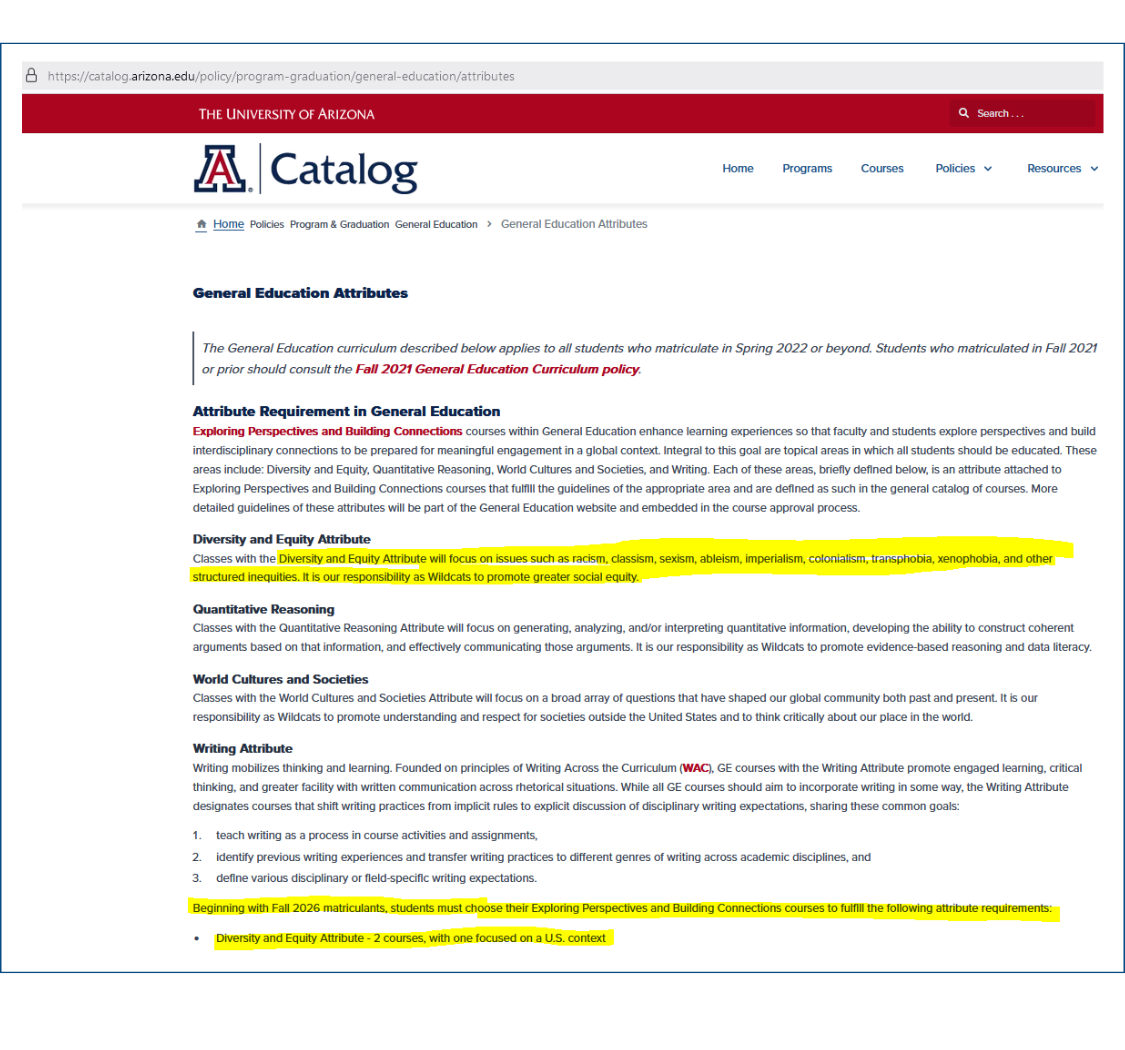
Conclusion: A Roadmap of What Must Be Done by State Lawmakers and/or Regents
With faculty governing bodies having abdicated their responsibility to promote intellectual inquiry free of ideological coercion—and university regents opting to ignore this development—state lawmakers now have an obligation to their taxpayers and students to intervene.
Particularly given that many state constitutions, such as Arizona’s, explicitly require that at public universities, “instruction furnished shall be as nearly free as possible,” there is little defense for artificially requiring students to choose from courses in topics that are often both ideologically extreme and intellectually vacuous, simply as a condition of graduating from the institution.
As the Director of Higher Education Policy at the Manhattan Institute, John Sailer, has observed, organizations such as American Association of University Professors (AAUP) have sought to conflate the principles of an individual professor’s “academic freedom” with a blank check for institutionally mandated extremism under the guise of “faculty self-governance.”
As Sailer notes, “The implication of the self-governance-is-paramount argument is that universities can do no wrong, that an outside intervention is, in and of itself, a violation of faculty’s rights…[But] This raises all sorts of hypothetical scenarios. A faculty senate could make its university’s core curriculum focus exclusively on pig anatomy… In all of these cases, it’s very stupid to say that an intervention from outside is some sort of affront to academic freedom.”
Faculty Opposition to State Intervention is Often Unprincipled & Politically Motivated
Moreover, much of the faculty opposition to state intervention is evidently as unprincipled as it is politically motivated. For example, the California Faculty Association cheered in August 2020 when the state government handed down its ethnic studies curricular mandate:
“On August 17, another day for the history books on inclusive learning as Governor Gavin Newsom signed AB 1460 into law. An Ethnic Studies requirement is now on its way to the California State University system.”
After unabashedly declaring that “CFA was a proud sponsor” of the legislation, this association of nearly 30,000 university professors, lecturers, and staff at the California State University system happily declared:
“California will be the first state in the nation to require that a four-year public higher education system offer Ethnic Studies as a graduation requirement, making California a leader in learning.”
Surely, if the autonomy of faculty governance were truly as sacrosanct as activist academics argue in opposition to conservative state lawmakers, such university representatives would not have cheered, much less sponsored, such sweeping state management over their curricular requirements.
State Lawmakers Must Enact the Florida Model and the Freedom from Indoctrination Act
Given the extraordinary subsidy currently being extracted from students and/or state taxpayers to sustain forced DEI course mandates across the country, it is essential that state lawmakers and/or boards of regents adopt a concrete policy response. Setting an example for this response, Florida has successfully eliminated DEI coursework from its general education catalogs by enacting new legislation requiring action by university leaders. As summarized by Politico:
“Florida universities are culling hundreds of general education courses. Universities that keep general education courses against recommendations from the Board of Governors run the risk of losing critical state funding.”
As the New York Times reported in November 2024:
“The courses can still be taken as electives. But faculty worry that enrollments could plunge, financially hurting the departments that house them.
“They’re starving undergraduate enrollment in our courses,” said Dr. Rainwater, the sociology professor. “The worry is they’ll then be able to take away whole programs and justify it by saying courses aren’t filling up.”
In other words, faculty recognize that much of the demand for their activist course content is propped up only by forcing students into limited selections of classes that include these offerings. Yet taxpayers have no obligation to provide such enormously lucrative artificial financial subsidies for this coursework, and students should not continue to be held hostage by these mandatory enrollment requirements.
Despite the success of Florida’s model, however, this report has illustrated the widespread and increasing pattern of public universities burying their DEI course requirements at lower levels than the general education catalog. Ideologically monolithic academics of faculty senates may believe it is essential for computer science majors to take additional DEI courses infused into their core classes, but students and state taxpayers should not be forced to indulge in this belief at enormous financial cost.
As a result, states should also adopt new legislation based on the model Freedom from Indoctrination Act, released in partnership by the Goldwater Institute and Speech First to eliminate all DEI requirements including at the major level. Under this legislation, only students actively seeking a degree in fields focused upon racial and gender identity shall find themselves steeped in the current avalanche of politicized DEI ideology.
Appendix & Additional Notes:
Actual Scope and Cost of DEI Course Mandates is Likely Significantly Greater Even than Amounts Identified
While there are limitations to each of the estimate approaches used in this analysis (e.g. the “cost of instruction per FTE student” measure reported to IPEDS spans both undergraduate and typically costlier graduate students), the comparison of four different measures provides a reliably conservative range of overall costs, even before considering the host of factors that would dramatically increase the projected total under a more comprehensive analysis.
Specifically, this analysis’s findings that DEI course mandates cost students and taxpayers $1.8 billion over each four-year period at minimum likely dramatically underestimates the true scope of DEI course requirements and associated costs in public higher education, as all of the following remain outside its analysis:
- DEI requirements applied at the college/school, department, program and/or major level, rather than to the entire undergraduate population. Among the institutions identified by Speech First alone, this includes:
-
- Rutgers University (School of Arts and Sciences)
- University of North Texas (College of Liberal Arts and Social Sciences)
- University of Michigan (College of Literature, Science, and the Arts)
- University of Pittsburgh (School of Arts and Sciences)
- University of Virginia (College of Arts and Sciences)
- University of Wyoming (School of Teacher Education)
- University of California Los Angeles
- College of Letters and Science
- School of the Arts and Architecture
- School of Education and Information Studies
- School of Music
- School of Public Affairs
- School of Theater, Film, and Television
- Public community college requirements, including the Maricopa County Community College District, which alone serves over 100,000 students in Arizona, and whose “Arizona General Education Curriculum” for students includes both a “Global or Historical Awareness” and a “Cultural Diversity in the U.S” requirement.
- Institutions outside Speech First’s original analysis, which covered fewer than 200 public institutions. In comparison, the federal IPEDS database lists over 800 public four-year institutions—with an aggregate full-time undergraduate enrollment of over 5 million students.
- Part-time undergraduate students, which IPEDS lists as over 2 million students at public universities nationally, including over 220,000 pupils at these 74 institutions alone.
- Graduate student enrollment, which IPEDS reports as over 1.5 million students at public universities nationally, including 440,400 students at the 74 institutions reviewed in this analysis alone, who may be subject to similar DEI program requirements as their undergraduate peers.
- Most additional global diversity requirements often implemented in tandem with the generic (U.S.) diversity requirements, where the focus is on international cultures, world history, foreign language, etc., rather than principles of identity politics in the United States.
- Expenditures on the larger universe of public higher education courses that informally infuse the tenets of DEI into instruction.
Additional Technical Notes:
The University of California System utilizes a fall, winter, and spring “quarter” system (for all campuses other than UC Berkeley and UC Merced), as does California Polytechnic State University, San Luis Obispo. As a result, this analysis calculates the tuition cost per course as one-twelfth of the reported annual amounts, given three standard terms per year and a typical courseload of four courses per term. The alternative cost estimates for these institutions are likewise adjusted accordingly.
Due to California statute requiring the inclusion of an ethnic studies general education requirement, this analysis includes all Cal State campuses listed in IPEDS as having a DEI course requirement, including those not identified in Speech First’s original report.









